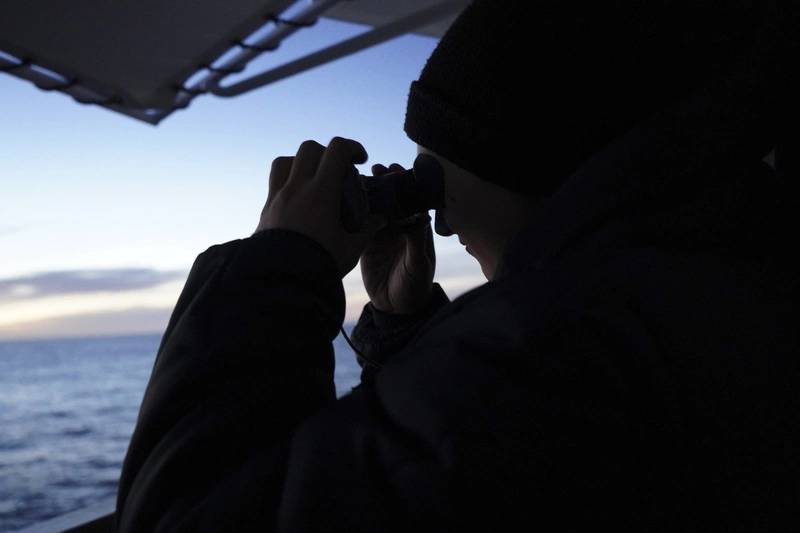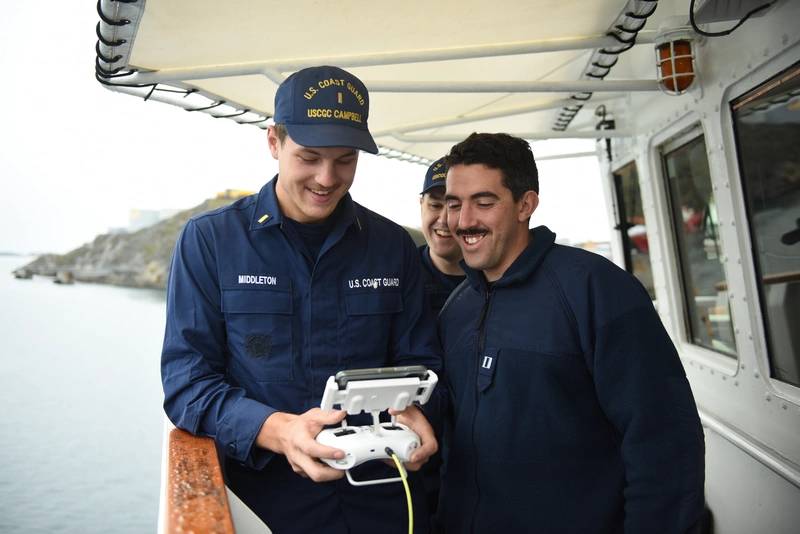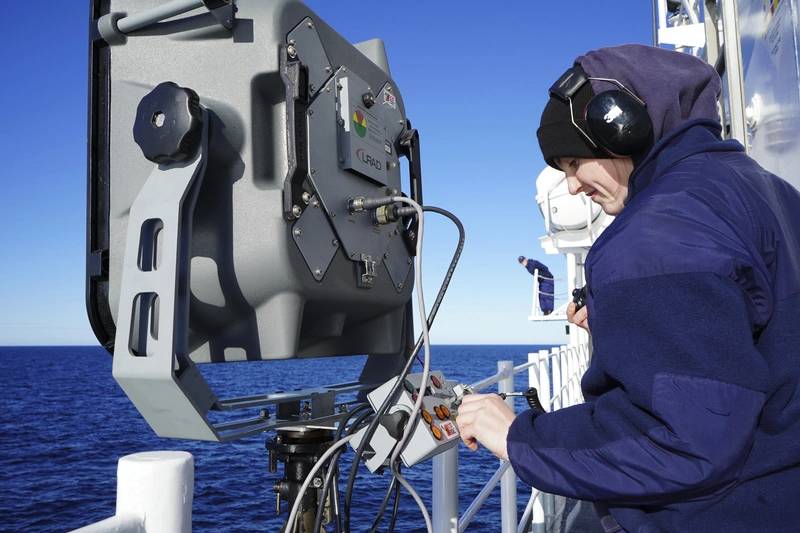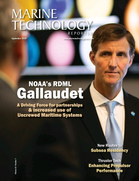Beyond the Tip of the Iceberg Tech: RDT&E's Annual Arctic Technology Evaluation
By Karin Messenger
The Coast Guard Research and Development Center (RDC) teamed up with Coast Guard Cutter Campbell’s crew this summer to evaluate five technologies as part of the RDC’s annual Arctic Technology Evaluation. The Campbell crew conducted the evaluations during their two-month deployment supporting joint Arctic operations off Greenland’s western coast, returning to their Kittery, Maine, homeport on Sept. 29, 2020.
“Testing various technologies by cutter crews for operation in cold and Arctic environments provides highlights on what works and what may need improvement, and can help influence tactics, techniques and procedures,” said Brian Dolph, who heads the RDC’s Surface Branch. “This work directly contributes to two lines of effort in the Coast Guard Arctic Strategic Outlook: ‘Enhance Capability to Operate Effectively in a Dynamic Arctic’ and ‘Innovate and Adapt to Promote Resilience and Prosperity.’ ”
The RDC adjusted its testing approach because of the COVID-19 pandemic; typically, at least one RDC staff member would be onboard the cutter as the lead scientist during testing. The year the RDC relied on detailed user manuals and technical reports produced for training and remote connectivity with the Campbell during testing. Matthew Lees served as the RDC demonstration director while Lt. Mathew Lara, Campbell operations officer, assigned duties aboard the ship.
The technologies selected for evaluation:
- Insight Mini Thermal Monocular (MTM) and AN/PSQ-20 Monoculars (enhanced night vision devices) for improved law enforcement and ice detection.
- Handheld Glare Helios laser for stand-off hailing capabilities.
- FiFish Remotely Operated Vehicle for underwater inspections in cold weather.
- Long Range Acoustic Device 500X-RE for enhanced communication with vessels at longer distances.
- Iridium Certus Terminal, which helped provide internet access for the crew to maintain communications with Atlantic Area.
 Amber Boguslawski utilizes the AN/PSQ-20 Monoculars (enhanced night vision devices) during a look-out watch on the bridge of the U.S. Coast Guard Cutter Campbell. U.S. Coast Guard photo by SN Kate Kilroy
Amber Boguslawski utilizes the AN/PSQ-20 Monoculars (enhanced night vision devices) during a look-out watch on the bridge of the U.S. Coast Guard Cutter Campbell. U.S. Coast Guard photo by SN Kate Kilroy
- Monoculars
The AN/PSQ-20 fused monoculars were evaluated on their ability to determine ice edge and targets of interest during normal watch operations; the technology was successful, especially at night. This technology allowed crew members to sight an iceberg quickly and give accurate data on size and shape.
The MTM was integrated via adapter cable to broadcast to the Campbell’s displays to support law enforcement and flight operations. “These tools functioned well to identify land, shipping and icebergs at night, providing detailed images of objects. Highly recommend future use,” said Capt. Thomas Crane, Campbell commanding officer.
- Handheld Glare Helios
The Glare Helios laser was tested in both day and night operations using a manned over the horizon (OTH) boat. During daylight hours, crewmembers onboard the OTH small boat detected the laser up to 8,000 yards from Campbell. During night hours, the laser was even more effective and could been seen over the horizon (approximately nine nautical miles). The Arctic environment did not hinder the operational ability of the Glare Helios.
The OTH crew reported it was immediately apparent the laser was pointed at them and believed the laser would be a valuable part of a boarding kit, especially when pursuing non-compliant vessels.
- FiFish Remotely Operated Vehicle (ROV)
The Coast Guard recently authorized the use of low-cost ROVs to enhance the effectiveness of the fleet; this demonstration proved this technology is also viable in polar environments. The demonstration highlighted maintenance efficiencies by reducing the number of crew-hours and risk to personnel required to perform time-consuming dives and providing on-demand inspection of hulls and piers.
 ENS Liam Middleton, LT Stephen Hills and ET1 Douglas Locklear run the FiFish Remotely Operated Vehicle (ROV) to inspect under the waterline of the CGC Campbell. U.S. Coast Guard photo by SN Kate Kilroy
ENS Liam Middleton, LT Stephen Hills and ET1 Douglas Locklear run the FiFish Remotely Operated Vehicle (ROV) to inspect under the waterline of the CGC Campbell. U.S. Coast Guard photo by SN Kate Kilroy
- Long Range Acoustic Device (LRAD) 500X-RE
Underscoring the challenges faced during Arctic operations, weather conditions were generally not favorable for small boat operations, but the LRAD provided clear hailing and communication to small boats up to 500 yards away.
- Iridium Certus Terminal
One of the biggest challenges for polar operations is effective communication. The Iridium Certus Terminal was used in this evaluation to provide a communication method every day, allowing for the easy transmission of multimedia messages and even the establishment of phone communications within the contiguous United States for the crew. “We tested this frequently throughout the patrol to analyze and document the operational suitability. Integrated into the shipboard telephone system, it provided clear communications for command and crew to make operational and emergency calls. It also proved to be highly effective as a back-up internet option when our high latitude operations challenged other technology,” Crane said.
Final results from these five technology evaluations are due at the end of the year.
Campbell also deployed 13 scientific research buoys ranging from the eastern shore of Nova Scotia to the Davis Strait. Daily images of icebergs were provided to the International Ice Patrol to validate and improve satellite reconnaissance. This effort allowed for real-time tracking and iceberg avoidance. “Varied scales of the operation area were readily available and provided over weekends, holidays and after work hours. This well-received, detailed, exceptional support greatly assisted in our operational planning and was critical to mission success,” Crane said.
Campbell’s crew also contributed to joint search and rescue exercises with the French and Royal Danish navies, facilitated key diplomatic engagements, and supported National Oceanic Atmospheric Administration and International Ice Patrol iceberg research during the 11,500-mile deployment. Campbell became the first 270-foot medium endurance cutter to earn the Arctic Service Medal.
“This effort strengthens international partnerships and provides a foundation for standard operations in the rapidly developing Arctic maritime environment,” said Vice Adm. Steven Poulin, commander U.S. Coast Guard Atlantic Area. “As interest and maritime traffic in the area increase, the importance of the U.S. Coast Guard’s interoperability with allied partners becomes more critical to ensuring we protect national and shared security interests. Exercising our unique blend of polar operational capability, regulatory authority, and international leadership across the full spectrum of maritime governance is vital to the future of the Arctic.”
About the Author: Ms. Karin Messenger is the Environment and Waterways and Arctic Domain Lead for the Coast Guard Headquarters Office of Research, Development, Test & Evaluation and Innovation.
 ENS Jordan Solseth runs a test for the Long Range Acoustic Device (LRAD) 500. U.S. Coast Guard photo by SN Kate Kilroy
ENS Jordan Solseth runs a test for the Long Range Acoustic Device (LRAD) 500. U.S. Coast Guard photo by SN Kate Kilroy


 August 2025
August 2025



